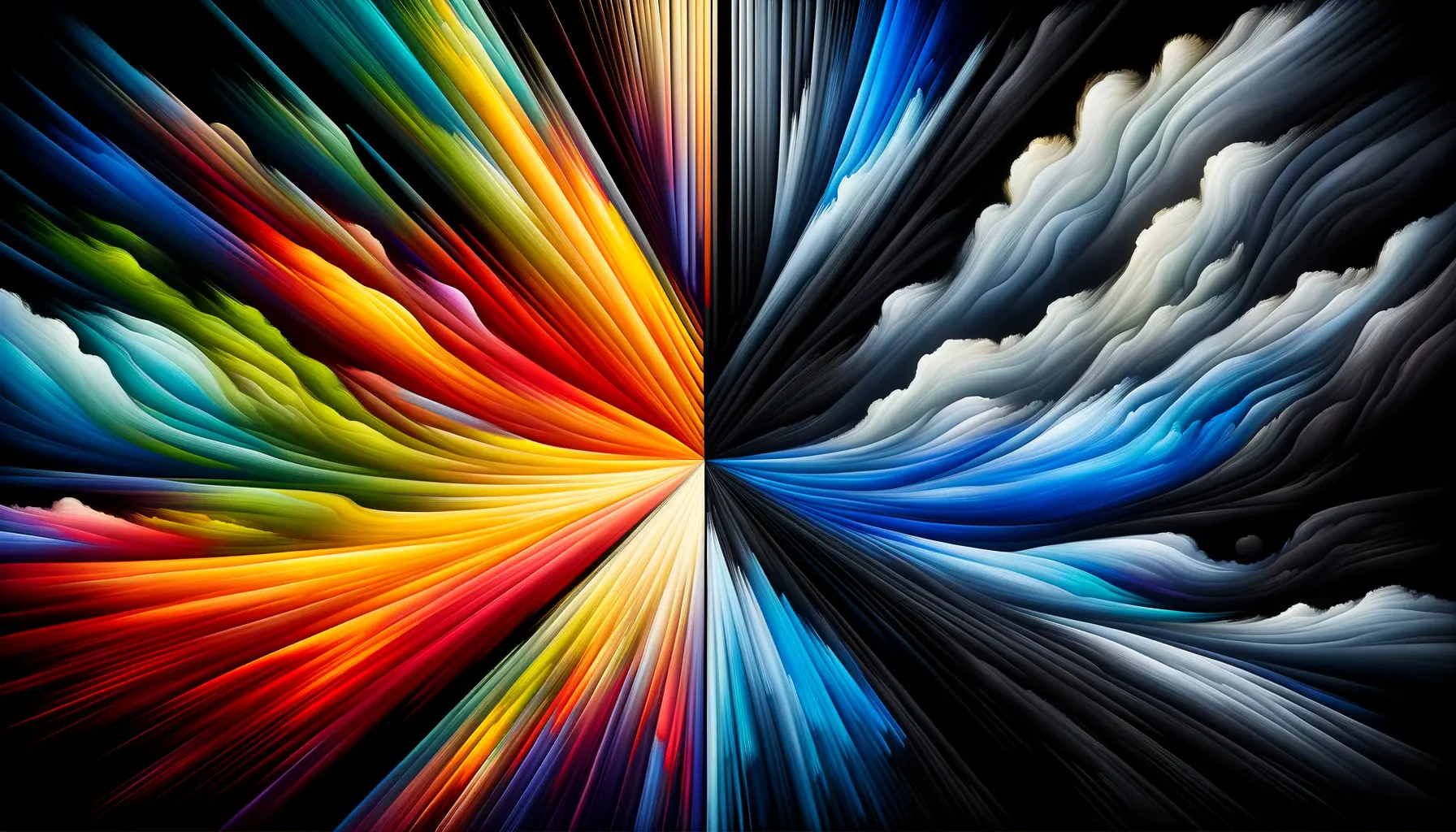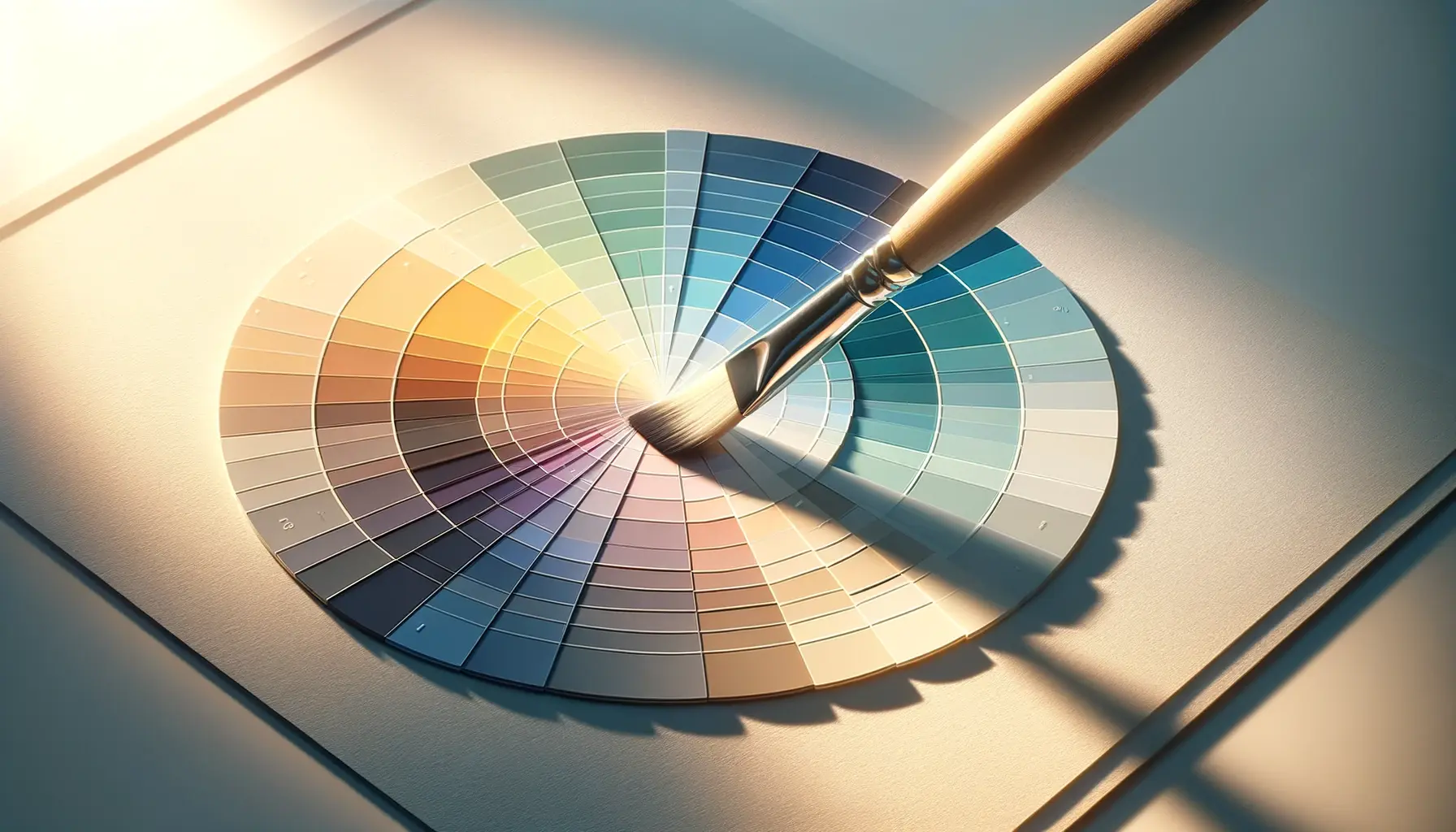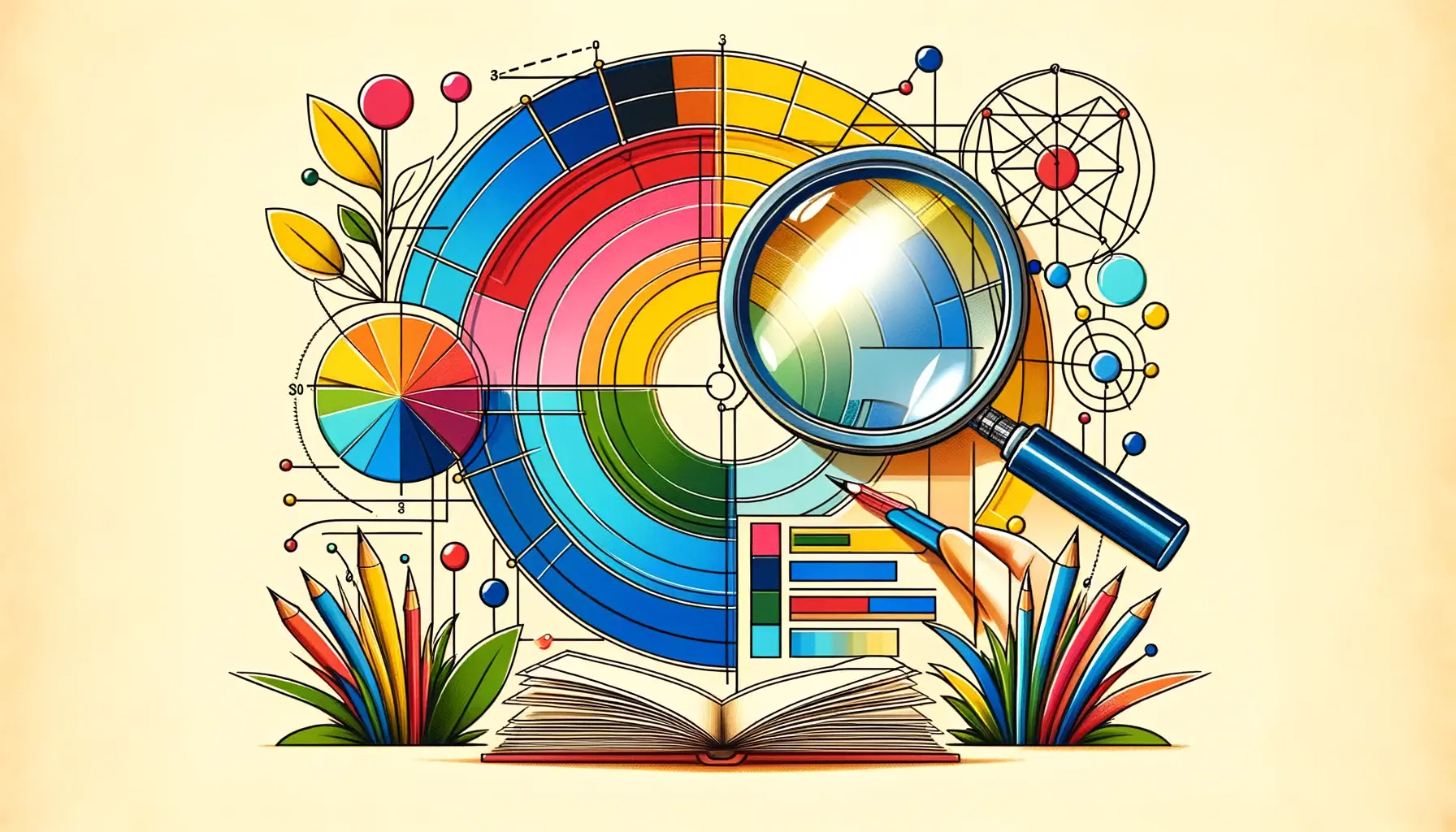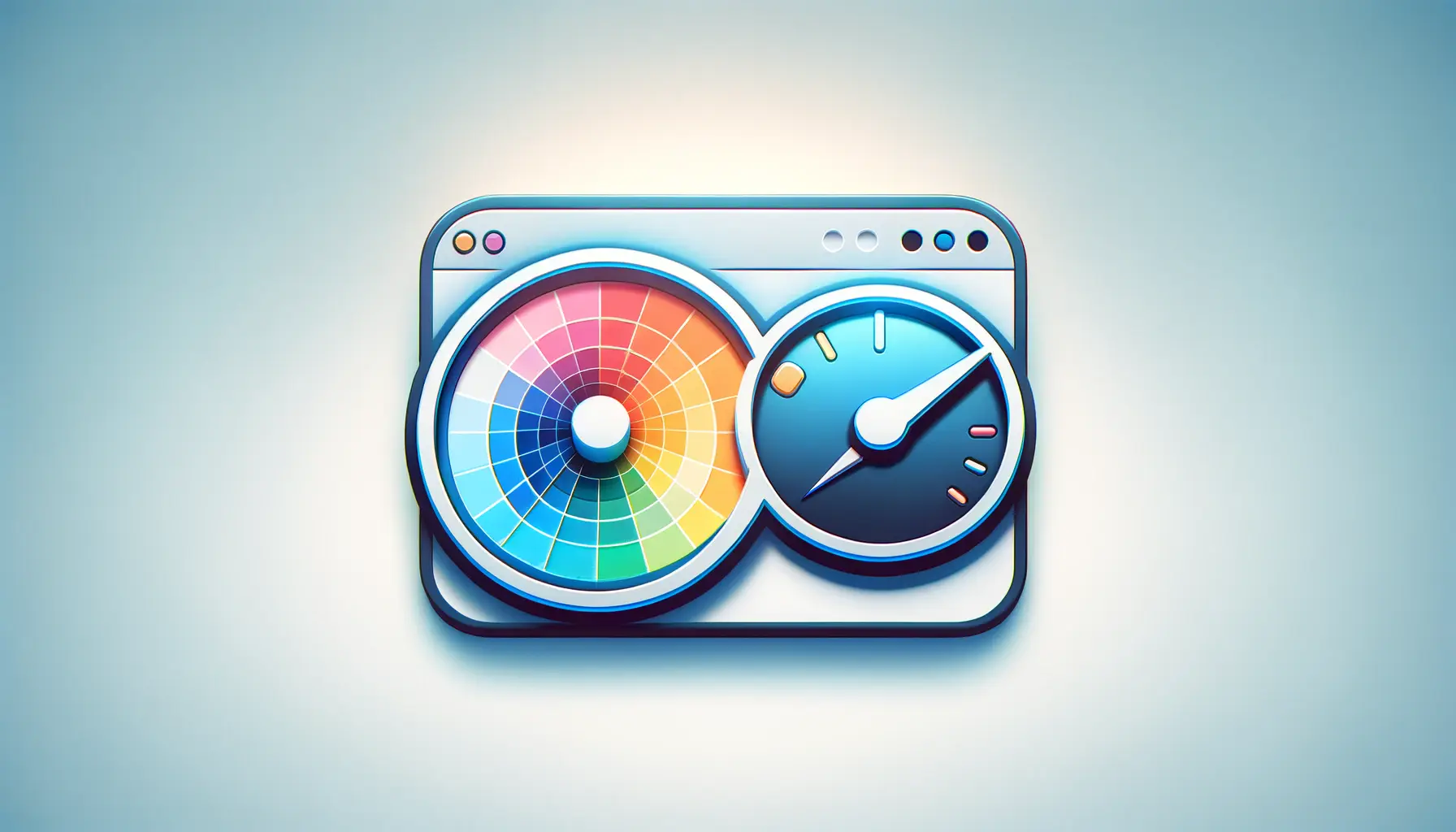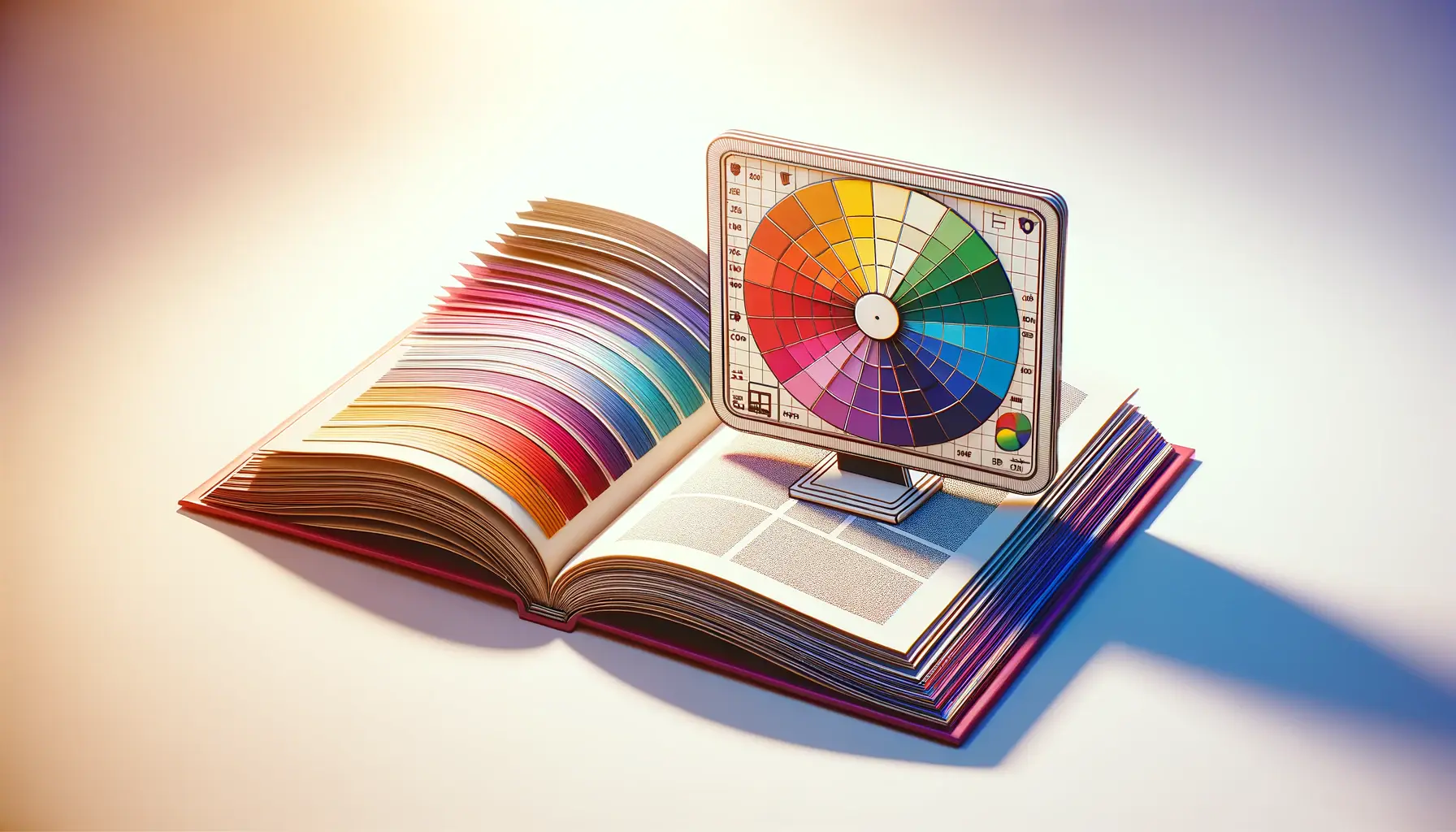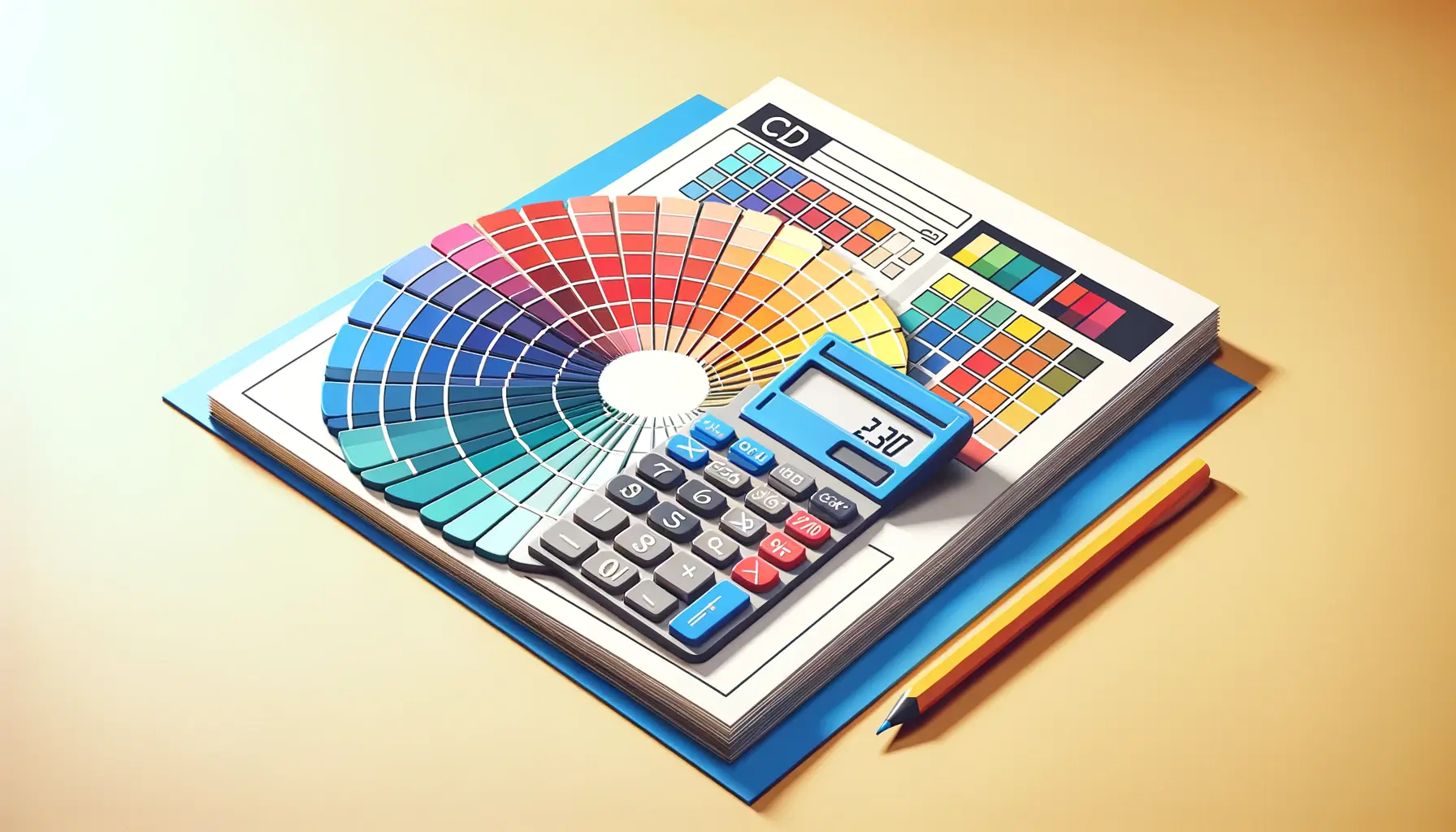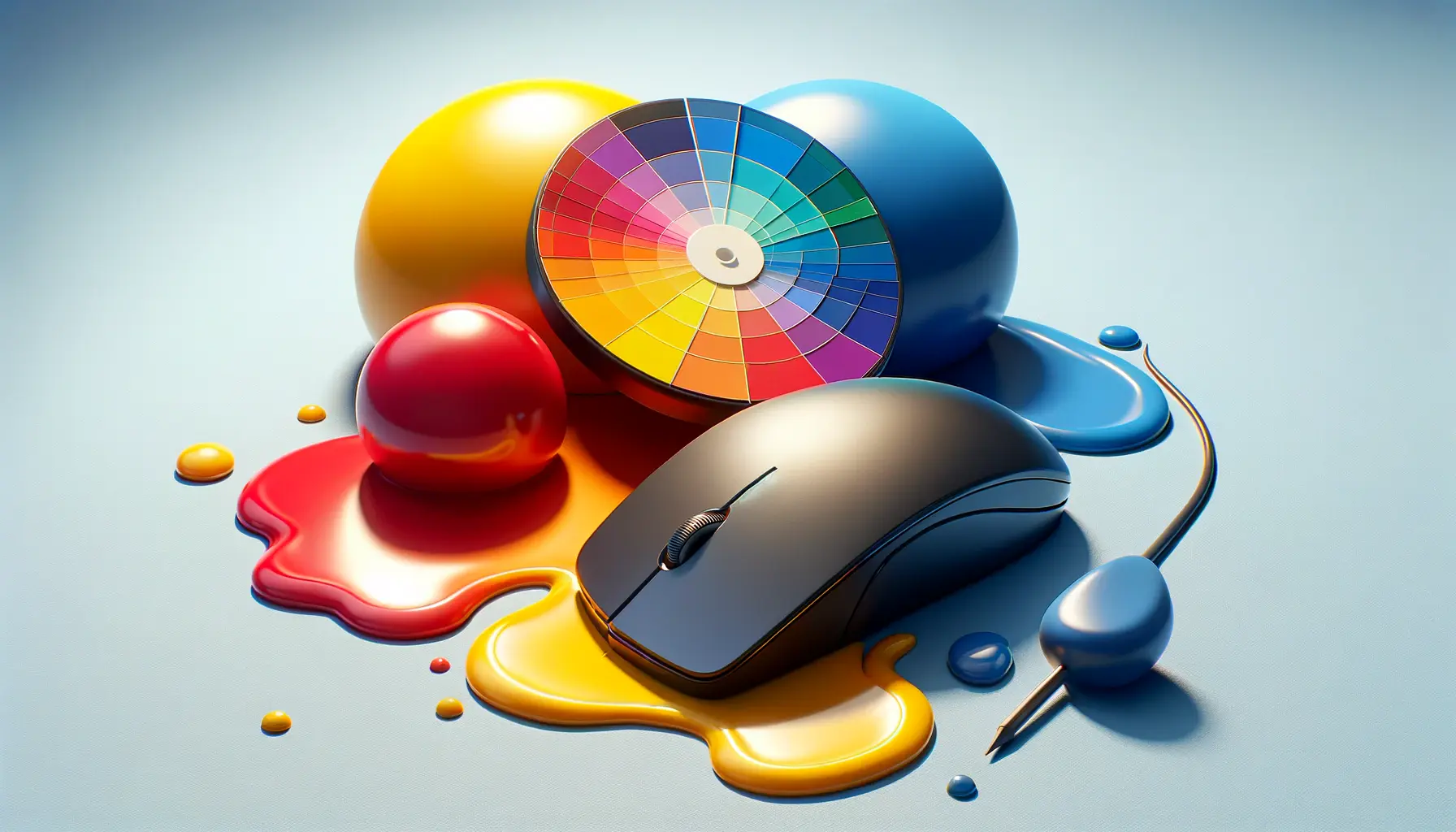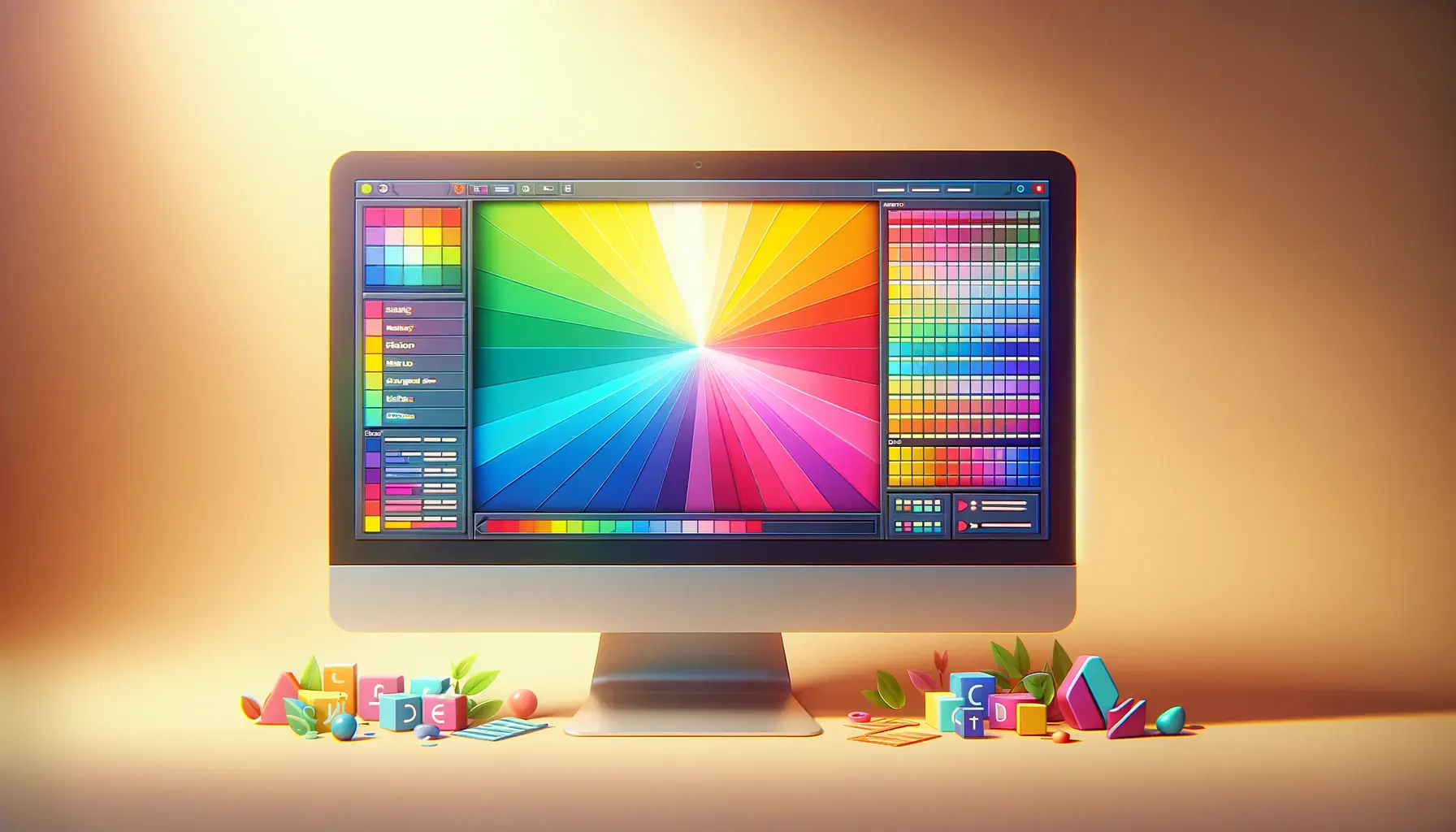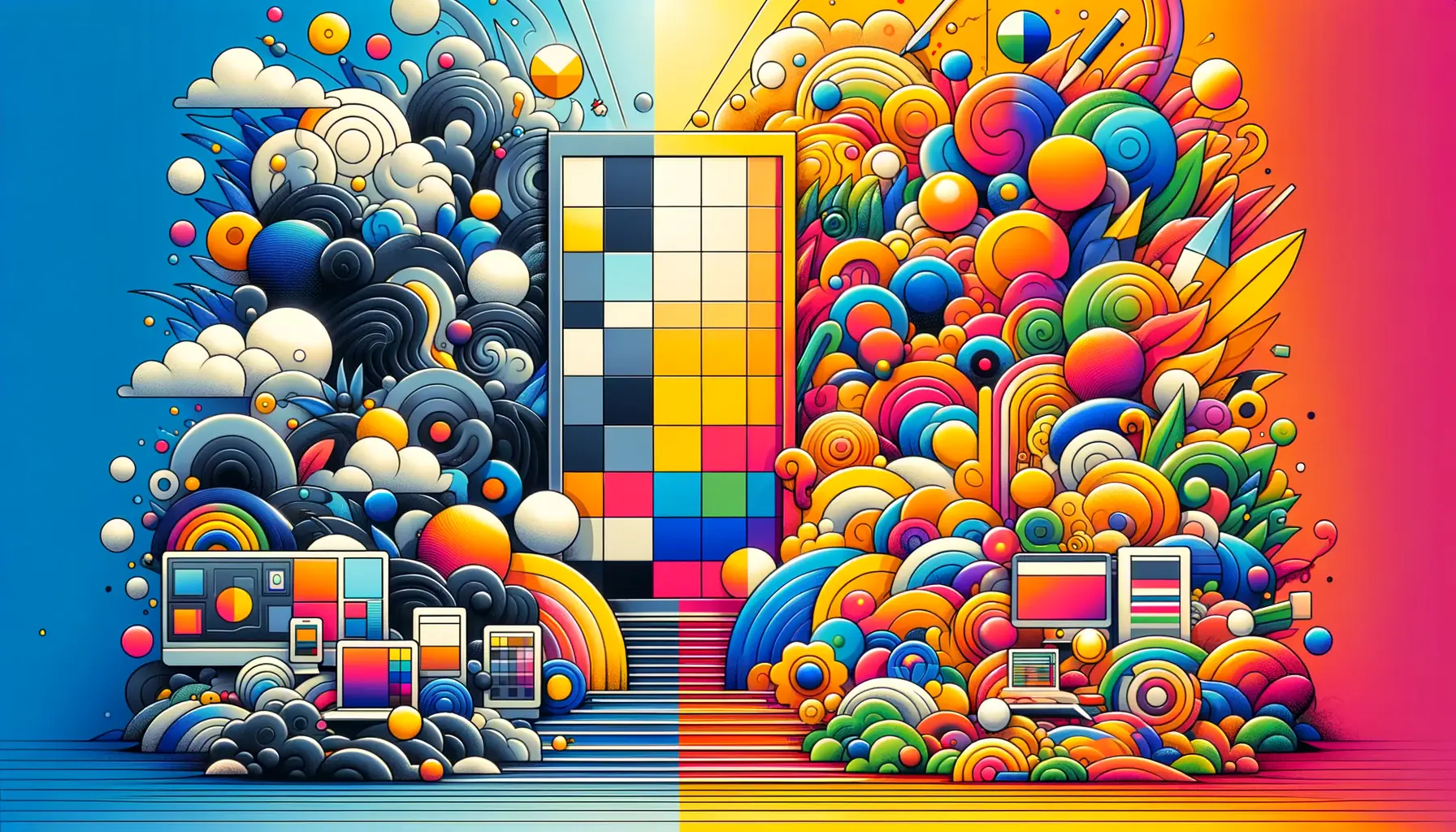Understanding the interplay between lightness and darkness in color theory is essential for anyone involved in the creative fields, especially in web design.
This concept is not just about choosing appealing color schemes but also about conveying emotions, creating depth, and guiding viewer perception.
Lightness and darkness, or the value of colors, play a pivotal role in how we interpret and engage with visual content.
By manipulating these elements, designers can create compositions that are not only visually striking but also deeply communicative.
The exploration of lightness and darkness within color theory is a journey into the way colors interact with each other and their surroundings.
It’s about understanding the psychological effects of color values on the viewer and using this knowledge to enhance the user experience.
Whether it’s the soothing effect of light pastels or the dramatic impact of dark hues, every color choice carries meaning and intention.
This article delves into the significance of these elements, offering insights into their application in web design color theory.
- Understanding Color Value
- Color Value in Web Design
- Color Psychology in Design
- Color Harmony and Contrast
- Impact of Lightness and Darkness on User Experience
- Techniques for Manipulating Color Value
- Future Trends in Color Value Usage
- Concluding Thoughts on Lightness and Darkness in Color Theory
- FAQs on Lightness and Darkness in Color Theory
Understanding Color Value
Color value, often referred to as lightness, is a fundamental aspect of color theory that describes the brightness or darkness of a color.
It is what distinguishes a light blue from a dark blue, even though they share the same hue.
Understanding color value is crucial for creating visual harmony and contrast in design.
By adjusting the value of colors, designers can achieve balance and emphasis, guiding the viewer’s attention to key elements of a composition.
Manipulating color value allows for the creation of depth and dimension within a design.
Lighter colors tend to advance, making them ideal for highlighting, while darker colors recede, providing a perfect backdrop that adds depth.
This principle is particularly useful in web design, where spatial relationships on a flat screen need to be carefully constructed to achieve a three-dimensional appearance.
Contrast and Visual Interest
Contrast is a powerful tool in the designer’s arsenal, and the manipulation of lightness and darkness is one of the most effective ways to achieve it.
High contrast between elements can make a design pop and ensure that important information stands out.
For instance, pairing a dark background with light text can enhance readability and draw attention to the content.
Conversely, low contrast schemes can create a subtle and harmonious look, ideal for backgrounds or less critical information.
However, it’s essential to strike the right balance.
Too much contrast can be jarring and overwhelming, while too little may result in a dull and uninspiring design.
The key is to use contrast intentionally to create focal points and guide the viewer’s eye through the design.
Effective use of contrast can significantly improve user engagement and content hierarchy in web design.
Emotional and Psychological Effects
The value of colors also has a profound impact on the emotional and psychological response of the viewer.
Light colors are often associated with positivity, openness, and tranquility, making them ideal for creating a friendly and inviting atmosphere.
Dark colors, on the other hand, can evoke feelings of sophistication, mystery, and power.
By carefully selecting the lightness and darkness of colors, designers can evoke specific moods and emotions, enhancing the overall message and tone of the design.
Moreover, the cultural context of colors and their values cannot be overlooked.
Different cultures may have varying interpretations and associations with certain colors and their lightness or darkness.
A deep understanding of the target audience and their cultural background is essential for creating designs that resonate on a deeper level.
Color Value in Web Design
The application of lightness and darkness in web design goes beyond aesthetic appeal; it directly influences usability and user experience.
A well-thought-out color scheme can enhance the functionality of a website, making it more intuitive and accessible for users.
Here, we explore how color value impacts various aspects of web design and how to leverage it for optimal results.
Enhancing Usability and Accessibility
One of the primary considerations in web design is ensuring that content is accessible and easy to navigate.
Color value plays a crucial role in achieving this by improving contrast and readability.
For example:
- Text and Background Contrast: Ensuring high contrast between text and its background color can significantly improve readability for users, including those with visual impairments.
- Interactive Elements: Using color value to differentiate interactive elements, such as buttons or links, from non-interactive elements helps users understand what actions they can take on a page.
Accessibility guidelines, such as the Web Content Accessibility Guidelines (WCAG), provide specific recommendations on contrast ratios to ensure that web content is accessible to a wider audience.
Adhering to these guidelines is not only a matter of inclusivity but also enhances the overall user experience.
Creating Depth and Dimension
Despite the inherently flat nature of web pages, designers can create an illusion of depth using color value.
This is achieved by:
- Layering: Applying lighter colors to elements that are meant to appear closer to the viewer and darker colors to those in the background.
- Shadows and Highlights: Adding shadows to elements can create a sense of them being raised above the surface, while highlights can suggest indentation.
This technique not only adds visual interest but also helps in organizing content by clearly distinguishing between different sections and elements on a page.
Guiding User Interaction
Color value can also guide users’ interactions with a website by drawing attention to key elements.
This includes:
- Call-to-Action Buttons: Using a contrasting color value for call-to-action buttons makes them stand out and encourages users to click.
- Navigation: Highlighting active or hovered-over navigation items with a change in color value can improve user orientation and navigation efficiency.
Thoughtful application of lightness and darkness can significantly enhance the navigational experience, leading to increased user engagement and satisfaction.
Setting the Tone and Atmosphere
The overall color scheme of a website, influenced by the values of the colors chosen, sets the tone and atmosphere of the user experience.
Lighter color schemes can create an open and airy feel, suitable for wellness or lifestyle websites, while darker schemes might be used to convey luxury or exclusivity, often seen in high-end product sites.
In conclusion, the strategic use of color value in web design is instrumental in creating visually appealing, accessible, and user-friendly websites.
By understanding and applying the principles of lightness and darkness, designers can effectively communicate, guide, and influence user interaction and perception.
Color Psychology in Design
The psychology of color is a pivotal aspect of design that goes beyond mere aesthetic considerations, delving into how colors and their values impact human emotion and behavior.
This understanding is crucial for designers aiming to evoke specific responses or convey certain messages through their work.
Here, we explore the psychological effects of lightness and darkness in colors and how they can be applied to enhance design projects.
Influence on Mood and Emotions
Colors have the power to influence mood and emotions significantly.
This influence can be attributed to their lightness or darkness:
- Light Colors: Generally associated with positive emotions, light colors can evoke feelings of happiness, peace, and relaxation. For instance, light blue can induce a sense of calmness, while light pink might convey romance and gentleness.
- Dark Colors: Often linked to more intense and sometimes negative emotions, dark colors can convey mystery, elegance, or sadness. Dark green, for example, might be associated with prestige, whereas dark gray could evoke solemnity.
By carefully selecting the value of colors, designers can create an emotional landscape that aligns with the message or tone they wish to convey.
Perception of Space and Size
The perceived space and size of an area can be manipulated through the use of light and dark colors.
This is particularly useful in interior design and web design, where the goal may be to make a space appear larger or more intimate:
- Expanding Space: Light colors are reflective, making spaces feel open and airy. Using light colors in small rooms or on websites can make them feel more expansive.
- Contracting Space: Dark colors absorb light, which can make spaces appear smaller and more confined. This technique can be used to create a sense of intimacy or focus.
Designers can leverage this aspect of color psychology to influence how users perceive the size and atmosphere of a space.
Color Associations and Cultural Significance
The psychological impact of color also extends to the associations and cultural significance attached to different colors and their shades.
These associations can vary significantly across different cultures and contexts:
- Lightness: In many cultures, light colors are associated with purity, innocence, and beginnings. For example, white is traditionally worn at weddings in Western cultures.
- Darkness: Dark colors may represent power, sophistication, or mourning. Black, for instance, is often worn at funerals in Western societies but can also signify luxury and elegance in fashion.
Understanding these cultural nuances is essential for designers to ensure their work resonates appropriately with the intended audience.
It’s important to research and consider the cultural context when choosing colors for a design project to avoid unintended connotations.
Enhancing Brand Identity
The strategic use of color psychology can also play a significant role in brand identity and marketing.
Brands often choose colors based on the emotions and associations they wish to evoke:
- Light Colors: Brands aiming to appear approachable and friendly might opt for lighter shades in their color palette.
- Dark Colors: Companies wishing to exude sophistication and exclusivity often favor darker hues.
By aligning color choices with brand values and the desired customer perception, companies can strengthen their identity and appeal to their target audience more effectively.
In conclusion, the psychological aspects of color value are a powerful tool in the designer’s toolkit.
By understanding and applying the principles of lightness and darkness, designers can influence emotions, perceptions, and behaviors, enhancing the effectiveness of their designs.
Color Harmony and Contrast
Color harmony and contrast are foundational elements in creating visually appealing designs.
They involve the strategic use of lightness and darkness to balance aesthetics and improve legibility.
Harmony brings a sense of order and cohesion, while contrast adds interest and highlights important elements.
This section explores how to achieve both harmony and contrast in design through the manipulation of color value.
Principles of Color Harmony
Color harmony involves the pleasing arrangement of colors that work well together, creating a balanced and cohesive look.
This can be achieved through:
- Analogous Colors: Using colors that are next to each other on the color wheel. For example, a combination of light blue, blue, and dark blue can create a serene and cohesive design.
- Monochromatic Scheme: Utilizing one color in varying values. A monochromatic scheme using shades, tints, and tones of green can offer depth while maintaining harmony.
Harmony is essential for creating designs that are easy on the eyes and convey a clear message.
It ensures that no single element overpowers others, allowing the design to be perceived as a unified whole.
Creating Contrast with Color Value
Contrast is the difference in visual properties that makes an object distinguishable from other objects and the background.
In terms of color value, contrast can be achieved by:
- Using Complementary Colors: Pairing colors opposite each other on the color wheel, such as light yellow and dark purple, to create high contrast and make elements stand out.
- Value Contrast: Placing light colors against dark colors to enhance readability and draw attention. For example, dark text on a light background or vice versa.
Effective use of contrast can guide the viewer’s attention to key areas, making it a critical tool for emphasizing content, creating hierarchy, and adding visual interest to a design.
Balance in Harmony and Contrast
Finding the right balance between harmony and contrast is crucial for successful design.
Too much harmony can lead to a bland and uninteresting composition, while too much contrast can be chaotic and overwhelming.
Designers must consider the overall effect they wish to achieve and adjust the color value accordingly to strike the perfect balance.
For instance, a website design might use a harmonious background with subtle variations in color value to create a calming effect, while employing high-contrast colors for call-to-action buttons to make them stand out.
A balanced approach to color harmony and contrast can significantly enhance the effectiveness and aesthetic appeal of a design.
Applying Harmony and Contrast in Various Design Fields
The principles of color harmony and contrast are not limited to web design; they are applicable across various design fields:
- Graphic Design: In creating logos and branding materials, harmony and contrast can help establish brand identity and ensure legibility.
- Interior Design: Color value can be used to create mood, define spaces, and highlight architectural details.
- Fashion Design: Designers use color value to create outfits that are visually appealing and express a certain style or trend.
By mastering the use of lightness and darkness, designers can create compelling and effective designs that communicate, persuade, and delight the viewer.
Impact of Lightness and Darkness on User Experience
The strategic use of lightness and darkness in design extends beyond visual appeal, significantly impacting the user experience (UX).
This impact is evident in how users interact with and perceive digital environments, influencing their overall satisfaction and engagement.
By understanding the nuances of color value, designers can craft experiences that are not only beautiful but also intuitive and user-friendly.
Enhancing Navigation and Readability
One of the primary ways lightness and darkness affect UX is through navigation and readability.
Proper contrast between text and background is crucial for readability, affecting the user’s ability to easily consume content.
For example:
- Light backgrounds with dark text can create a high-contrast environment that is easy on the eyes, facilitating longer reading sessions without strain.
- Dark modes, which use dark backgrounds with light text, have gained popularity for reducing eye strain in low-light conditions and offering a sleek, modern look.
Moreover, the use of color value can guide users through a website or application, highlighting interactive elements like buttons and links, and indicating active states or areas of importance.
Creating Emotional Connections
The emotional impact of lightness and darkness on users is profound.
Colors and their values can evoke specific emotions and feelings, influencing how users perceive a brand or product.
For instance:
- Lighter shades are often associated with openness, cleanliness, and positivity, making them ideal for brands wanting to convey trustworthiness and friendliness.
- Darker shades can evoke luxury, sophistication, and mystery, suitable for premium brands aiming to create an aura of exclusivity.
By carefully selecting color values that align with the desired emotional response, designers can create a more engaging and memorable user experience.
Improving Accessibility and Inclusivity
Accessibility and inclusivity are critical considerations in modern design, ensuring that digital products are usable by everyone, including individuals with visual impairments.
Lightness and darkness play a key role in accessibility, particularly in:
- Contrast ratios: Adhering to recommended contrast ratios ensures that text is legible and interactive elements are distinguishable for users with low vision or color blindness.
- Color blindness considerations: Using color value effectively can help differentiate elements in a way that is not solely reliant on color, aiding users with color vision deficiencies.
Designs that prioritize accessibility not only comply with legal standards but also reach a wider audience, enhancing the overall user experience.
Incorporating best practices for lightness and darkness in design can significantly improve usability, emotional engagement, and accessibility, leading to a superior user experience.
Adapting to User Preferences and Contexts
Finally, the flexibility to adapt designs based on user preferences and contexts, such as light or dark mode settings, can further enhance UX.
Allowing users to choose their preferred color scheme empowers them to customize their experience based on personal preferences or situational needs, such as switching to dark mode at night to reduce blue light exposure.
This adaptability not only improves comfort and satisfaction but also reflects a brand’s commitment to user-centric design, fostering positive perceptions and loyalty.
In conclusion, the thoughtful application of lightness and darkness in design is a powerful tool for enhancing user experience.
By improving readability, evoking emotions, ensuring accessibility, and accommodating user preferences, designers can create engaging and inclusive digital environments that meet and exceed user expectations.
Techniques for Manipulating Color Value
Manipulating the value of colors is a skill that designers use to create depth, emphasis, and mood in their work.
Understanding how to effectively adjust lightness and darkness can transform a design, making it more dynamic and engaging.
This part of the article explores various techniques for manipulating color value and how they can be applied in design projects.
Gradient and Blending
Gradients and blending techniques are powerful tools for creating a smooth transition between different values of the same color or between multiple colors.
This can add depth and dimension to a design, creating a more immersive experience.
For example:
- Backgrounds with a light to dark gradient can create the illusion of space, drawing the viewer’s eye towards a focal point.
- Blending colors with varying values can create a dynamic and vibrant look that adds visual interest and movement to the design.
Gradients are particularly effective in web design and digital art, where they can be used to create backgrounds, buttons, and hover effects that enhance the user interface.
Layering and Texture
Layering different colors and textures can also manipulate the perceived value of colors.
By overlaying light colors on dark backgrounds (or vice versa), designers can create contrast and highlight specific elements.
Additionally, incorporating textures can add depth and richness to the design, making it more tactile and visually appealing.
Techniques include:
- Using semi-transparent layers to adjust the value of underlying colors, creating a sense of depth.
- Incorporating textured patterns with varying values to add complexity and interest to flat surfaces.
This approach is useful in graphic design, illustration, and web design, where layering can be used to create visually striking compositions.
Shadows and Highlights
Adding shadows and highlights is a direct method of manipulating color value to create the illusion of three-dimensionality.
This technique can make objects appear more lifelike and grounded in their environment.
Applications include:
- Drop shadows under text or objects to create the illusion of elevation above the background.
- Highlights on edges or surfaces to simulate lighting effects and give objects a rounded appearance.
Shadows and highlights are essential in UI/UX design, where they can enhance the realism of icons, buttons, and other interface elements, improving usability and aesthetic appeal.
Experimenting with shadows and highlights can dramatically change the perception of space and form in digital designs.
Color Adjustment Tools
Modern design software offers a range of tools and features for adjusting color value, including sliders for brightness, contrast, and saturation.
These tools allow designers to fine-tune colors with precision, ensuring that they convey the desired mood and emphasis.
Learning to use these tools effectively is crucial for:
- Adjusting the lightness and darkness of images and graphics to fit the overall design scheme.
- Enhancing the visual impact of designs by tweaking color values for maximum contrast and harmony.
Whether working on digital illustrations, web design, or any other creative project, mastering color adjustment tools is essential for manipulating color value and achieving the desired outcome.
In conclusion, the ability to manipulate color value is a fundamental skill for designers, allowing them to create more engaging, dynamic, and effective designs.
By employing techniques such as gradient blending, layering, adding shadows and highlights, and utilizing color adjustment tools, designers can enhance the visual appeal and functionality of their projects.
Future Trends in Color Value Usage
The dynamic nature of design means that trends in color value usage are constantly evolving.
As technology advances and cultural preferences shift, the ways in which designers manipulate lightness and darkness in their work continue to develop.
This section explores potential future trends in color value usage and their implications for design.
Adaptive Color Schemes
With the increasing importance of user experience in design, adaptive color schemes that change based on environmental conditions or user preferences are becoming more prevalent.
This includes:
- Automatic switching between light and dark modes based on the time of day or ambient light conditions.
- Customizable color schemes that allow users to adjust the lightness and darkness of interfaces according to their preferences or needs.
These adaptive schemes not only enhance usability and accessibility but also represent a shift towards more personalized and responsive design approaches.
Augmented Reality and Virtual Reality
As augmented reality (AR) and virtual reality (VR) technologies become more integrated into design practices, the manipulation of color value will play a crucial role in creating immersive experiences.
Designers will need to consider how lightness and darkness affect spatial perception and user interaction within virtual environments.
This could involve:
- Using color value to create depth and guide user navigation in virtual spaces.
- Manipulating light and shadow to enhance the realism of virtual objects and environments.
The application of color value in AR and VR presents exciting opportunities for creating engaging and lifelike experiences.
Sustainability and Color Value
As global awareness of environmental issues grows, sustainability is becoming a key consideration in design.
This trend extends to color value usage, with designers exploring how lightness and darkness can contribute to energy efficiency.
For example:
- Dark modes in digital interfaces can reduce energy consumption on OLED and AMOLED screens.
- Using color schemes that require less backlighting on devices, extending battery life and reducing energy use.
This focus on sustainability represents a shift towards more eco-friendly design practices, where color value plays a role in minimizing environmental impact.
Assuming that dark mode is universally energy-efficient is a misconception. Its impact varies depending on the technology used in screens and devices.
Psychological and Cultural Shifts
As societal attitudes and cultural norms evolve, so too do the psychological and cultural connotations of color.
Future trends in color value usage may reflect these shifts, with designers using lightness and darkness to tap into emerging moods and themes.
This could involve:
- Exploring new associations with light and dark colors as cultural perceptions change.
- Adapting color schemes to reflect societal trends, such as a move towards minimalism or digital detoxing.
Staying attuned to these psychological and cultural shifts will enable designers to create work that resonates with contemporary audiences.
In conclusion, the future of color value usage in design is set to be influenced by technological advancements, a growing focus on user experience, sustainability concerns, and shifting cultural landscapes.
By staying informed of these trends, designers can continue to innovate and create designs that are not only visually compelling but also meaningful and relevant.
Concluding Thoughts on Lightness and Darkness in Color Theory
The exploration of lightness and darkness within color theory unveils a rich tapestry of techniques and principles that are fundamental to creating compelling designs.
As we have seen, the strategic manipulation of color value can significantly influence the user experience, guiding perception, evoking emotions, and ensuring accessibility.
The future trends in color value usage promise even greater possibilities for innovation and personalization in design, reflecting technological advancements and shifting cultural norms.
The Essence of Color Value in Design
At its core, the interplay between lightness and darkness is about balance.
Achieving the right contrast and harmony in design is not merely a technical skill but an art form that requires intuition and sensitivity to the nuances of color.
Whether it’s enhancing readability through high contrast or creating mood with subtle shifts in value, designers wield the power to shape user interactions and emotional responses through their color choices.
Embracing Future Possibilities
The evolving landscape of design technology and cultural preferences presents new challenges and opportunities for working with color value.
Adaptive color schemes, the integration of AR and VR, a focus on sustainability, and the acknowledgment of psychological and cultural shifts are just the beginning.
Designers must remain curious and adaptable, ready to explore new horizons in color theory and its application.
- Adaptive color schemes will cater to user preferences and environmental conditions, enhancing personalization and accessibility.
- AR and VR technologies will demand innovative approaches to using color value to create immersive and realistic experiences.
- Sustainability considerations will influence color choices, promoting energy-efficient and environmentally friendly design practices.
- Psychological and cultural shifts will continue to shape color trends, requiring designers to stay attuned to societal changes and emerging themes.
In conclusion, the role of lightness and darkness in color theory extends far beyond aesthetic considerations, touching on aspects of psychology, technology, and culture.
As designers, our challenge and privilege is to harness the full potential of color value, crafting experiences that resonate on a deep level with our audience.
By embracing the principles of color theory and staying abreast of future trends, we can continue to push the boundaries of what is possible in design.
Quality web design is key for a great website! Check out our service page to partner with an expert web design agency.
FAQs on Lightness and Darkness in Color Theory
Explore common questions about the intricate role of lightness and darkness in color theory, providing insights into how these elements influence design and perception.
Lightness refers to the perceived brightness of a color, influenced by the amount of light a color reflects, ranging from white (maximum lightness) to black (minimum lightness).
Darkness in color can evoke depth, sophistication, and sometimes solemnity, significantly influencing the mood and atmosphere of a design by adding weight and intensity.
Contrast in color theory highlights the difference in values between colors, enhancing visual interest, readability, and the overall effectiveness of the design.
Yes, manipulating lightness and darkness can significantly improve usability by enhancing contrast, guiding user attention, and ensuring content is accessible and legible.
Light colors tend to be perceived as more spacious and calming, while dark colors can create a sense of intimacy and sophistication, affecting spatial perception.
Color value can convey brand personality, with light colors often associated with approachability and dark colors with luxury or seriousness, impacting brand perception.
Color value is crucial in accessibility, with high contrast between text and background improving readability for users with visual impairments.
Future trends may include adaptive color schemes for enhanced personalization, and a focus on sustainability, influencing how designers utilize lightness and darkness.
